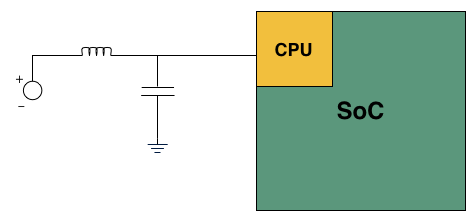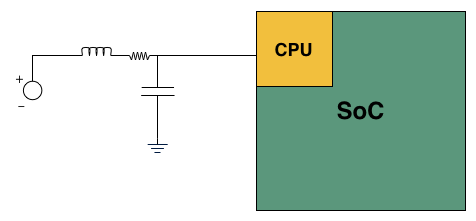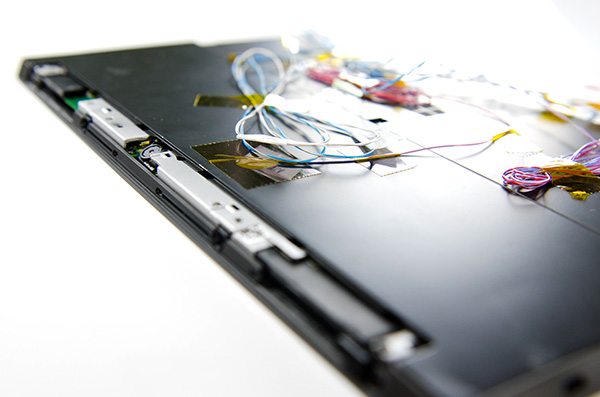The ARM vs x86 Wars Have Begun: In-Depth Power Analysis of Atom, Krait & Cortex A15
by Anand Lal Shimpi on January 4, 2013 7:32 AM EST- Posted in
- Tablets
- Intel
- Samsung
- Arm
- Cortex A15
- Smartphones
- Mobile
- SoCs
Late last month, Intel dropped by my office with a power engineer for a rare demonstration of its competitive position versus NVIDIA's Tegra 3 when it came to power consumption. Like most companies in the mobile space, Intel doesn't just rely on device level power testing to determine battery life. In order to ensure that its CPU, GPU, memory controller and even NAND are all as power efficient as possible, most companies will measure power consumption directly on a tablet or smartphone motherboard.
The process would be a piece of cake if you had measurement points already prepared on the board, but in most cases Intel (and its competitors) are taking apart a retail device and hunting for a way to measure CPU or GPU power. I described how it's done in the original article:
Measuring power at the battery gives you an idea of total platform power consumption including display, SoC, memory, network stack and everything else on the motherboard. This approach is useful for understanding how long a device will last on a single charge, but if you're a component vendor you typically care a little more about the specific power consumption of your competitors' components.
What follows is a good mixture of art and science. Intel's power engineers will take apart a competing device and probe whatever looks to be a power delivery or filtering circuit while running various workloads on the device itself. By correlating the type of workload to spikes in voltage in these circuits, you can figure out what components on a smartphone or tablet motherboard are likely responsible for delivering power to individual blocks of an SoC. Despite the high level of integration in modern mobile SoCs, the major players on the chip (e.g. CPU and GPU) tend to operate on their own independent voltage planes.

A basic LC filter
What usually happens is you'll find a standard LC filter (inductor + capacitor) supplying power to a block on the SoC. Once the right LC filter has been identified, all you need to do is lift the inductor, insert a very small resistor (2 - 20 mΩ) and measure the voltage drop across the resistor. With voltage and resistance values known, you can determine current and power. Using good external instruments (NI USB-6289) you can plot power over time and now get a good idea of the power consumption of individual IP blocks within an SoC.

Basic LC filter modified with an inline resistor
The previous article focused on an admittedly not too interesting comparison: Intel's Atom Z2760 (Clover Trail) versus NVIDIA's Tegra 3. After much pleading, Intel returned with two more tablets: a Dell XPS 10 using Qualcomm's APQ8060A SoC (dual-core 28nm Krait) and a Nexus 10 using Samsung's Exynos 5 Dual (dual-core 32nm Cortex A15). What was a walk in the park for Atom all of the sudden became much more challenging. Both of these SoCs are built on very modern, low power manufacturing processes and Intel no longer has a performance advantage compared to Exynos 5.
Just like last time, I ensured all displays were calibrated to our usual 200 nits setting and ensured the software and configurations were as close to equal as possible. Both tablets were purchased at retail by Intel, but I verified their performance against our own samples/data and noticed no meaningful deviation. Since I don't have a Dell XPS 10 of my own, I compared performance to the Samsung ATIV Tab and confirmed that things were at least performing as they should.
We'll start with the Qualcomm based Dell XPS 10...











140 Comments
View All Comments
some_guy - Saturday, January 5, 2013 - link
I was reading comments about how Intel can't compete on price because it will cannibalize profits from higher margin chips.My sense is that Intel will aggressively attempt to squash ARM just like cored AMD. I think they are aware of the imminent threat.
Cannibalizing their own profits from higher margin chips is inevitable and may be a better choice than being eaten alive by ARM.
(BTW I didn't read all 11 pages of comments, so sorry if this was already stated.)
nofumble62 - Saturday, January 5, 2013 - link
Intel current margin is >60% but its stock price didn't rise an inch.The concern is about architecture and future.
As long as they can get into mobile and get market share back, their stock price will spike.
So YES, they can and will drop the price to compete. Their cheap smartphones are already in store in India, China, and Europe.
Don't forget that there are plenty of companies doing well with much smaller margin.
mugiebahar - Saturday, January 5, 2013 - link
While theory will agree, it's not so easy. Simple illustration (only in smart phone tablets)Company 1 (ARM) - employes 1 person and works from home.
Company 2 (Intel) - employes 100 people and rents a warehouse.
Cost to run business 1 - ?
Cost to run business 2 - ???
ARM owns the market now (just for now is all I'm saying) - revenue per expenses = great
Intel is negligible - revenue to expenses = disaster (not that won't change, but the
money spent already over the years)
Company 1 has loyalty and legacy in this market.
Company 2 is HOPING it has loyalty and the it legacy support will matter in this market!
The article makes it seem that it's a one deal Intel will be in the marke and we just have to wait. But that's wrong. Right now we are having phone that can do everything we need at the moment. Yes it will get better but we don't need the leaps n bounds anymore @ a cost we really don't need to spend.
Also if Intel sells a core CPU SoC and it goes for 20-30 like ARM SoC. uneducated people will look at it as an insult that the desk top costs so much. And while its completely different levels of power average joe won't know, and humans are the worst critics correct? I stated before its not about intel not being able to make a chip. It's their company s structured so wrong for this market. You have to be small and agie. AMD would have a better shot at it, if they had the smarts.
some_guy - Sunday, January 6, 2013 - link
It could get ugly.Intel will not give up the high end ARM market without a fight because next stop is desktop market. And Intel may not succeed.
Apple is already majorly moving away from Intel which gives the lots of leverage.
This may be Intel's long twilight, and AMD's shorter twilight.
CuriousSoul - Saturday, January 5, 2013 - link
Without knowing the Frames Per Second, Games settings for 3D Game 1 how is is possible to compare all of the graphs in any sense other than maximum mW ?It's like saying a VW Golf is more frugal around a race track than a Ferrari !
One resistor could draw 1mW and another 1000mW but which is better at the actual 3D Game 1? (in this case they offer an identical experience).
Cold Fussion - Saturday, January 5, 2013 - link
Yea this was mentioned multiple times before, It doesn't do very much to alleviate the claims of Anand's Intel bias does it?jameskatt - Sunday, January 6, 2013 - link
The first problem for Intel is that every major ARM chip company develops their own ARM chips. Apple does it. Samsung does it, etc. This means that these companies will NOT buy third party CPU/GPUs for their ARM devices. By developing their own ARM chips, they cut out Intel as the middle man and Intel's profits. For low priced devices, it is crucial to do this since margins can be very low or in Apple's case, the need to make profit is very high. These companies will not be Intel customers for chips. Intel is locked out. This is why Texas Instruments got out of the ARM business.The second problem for Intel is that the ARM-chips have a huge ecosystem supporting it. Apple has their iOS software kingdom with over a million apps. Android has it hundreds of thousands of apps. These ecosystems have a heavy momentum of their own. Their number dwarfs the number of apps available to the Intel platform. Thus Intel has a difficult job convincing anyone to incorporate its CPUs in to devices which will automatically be incompatible for the existing ecosystems.
What Intel can do is to simply keep aggressively developing its own chips so that they can compete strongly with the ARM chips so that Intel can keep the ecosystem it currently has - laptops, desktops, mainframe and supercomputers.
Intel won't be able to compete on price. it has to make its own profits. It won't be able to compete at the bottom of the device market. But it certainly can keep and expand its own arena. Microsoft surface tablets are an example of an attempt to keep its own ecosystem.
omind - Monday, January 7, 2013 - link
James,Intel is not trying to sell IP to existing ARM chip companies (Samsung, Nvidia etc) but instead are creating complete SOCs, including GPU, Video en- and decoders and so on. They are positioning themselves as competitiors to SOC manufacturers not as suppliers.
Secondly, the Atoms already in the market (Medfield) can leverage the Android app ecosystem. This is accomplished by a version of Android's Dalvik adapted to the x86 ISA. I personally own a Medfield-powered Motorola Razr-i and I can say that every single app I downloaded from Google's play store does run without any problem whatsoever on it. Contrary to the popular belief, there is no ecosystem problem for the end user.
Best regards
mrdude - Wednesday, January 9, 2013 - link
I think his point is that today the big device makers are also have their own SoCs, thus locking Intel out from the beginning. The push towards vertical integration threatens Intel drastically. And unlike a Qualcomm, Intel currently has very little to offer that stands out from the rest of the competition in the tablet and smartphone space (I say tablet because the sales of x86 tablets has been really poor. Consumers don't value x86 compatibility on their tablet)Intel just can't compete on price. I know this gets brought up endlessly but it's something that's absolutely true. Intel operates on sky high margins and that's something that's impossible to do if you're only making SoCs for tablets and smartphones. If the high end is cannibalized at an accelerating rate going forward (and the figures I've read point to this) then Intel is going to be in big big trouble. There's just no way the company can maintain its sky high margins and even keep its own fabs (and R&D) by selling ~$20 SoCs. It's just not gonna' happen. Either Intel provides something that only they can offer and that's wanted by every device maker and consumer and warrants a higher price tag or they begin their slow march downhill.
wsw1982 - Friday, January 11, 2013 - link
Intel sell much more processors today than they were in 2010/2009, if they can maintain their own fabs then, I don't see the reason why they cannot now. The $20-$30 SOC is new market for Intel, not a replacement (at least in near feature). The additional market should be welcomed, right? It reminded me that back to 2008 when Intel first introduced the ATOM, a lot of genius started to cry that Intel opened the netbook market and sale chip at $30 and it would cannibalize the notebook market and hurt Intel's profit. But the years after are one of intel's fast growing age.As for the price? Why cannot Intel compete? doesn't it have enough revenue (PC&Server revenue is much more than 2010 and 2009) to even up the R&D? does it need to pay a bloody foundry fee to TSMC (who alone enjoy 40% margin)? does it have to pay a license fee to ARM? Doesn't it already spend a forturn on PR? Doesn't it already have the manufacture volume ? (50% in idle, anyway will be wasted, why don't produce something at least earn some money)
And I think Intel is never as competitive as now. It gaining it position in server market for the last few year, it's pc business has never such high market share, it's mobile chip start to crush ARM in any respect.
http://www.phonearena.com/news/Intel-Atom-powered-...
check this out, the smart phone lenovo K900 score more than 25000 in Antutu on a 1080P display, which not only crush snapdragon pro (4 krait) in Optimus G but also the newly release Samsung Exynos 5440 (2 A15) in Nexus 10